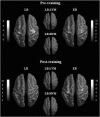Prior Visual Experience Modulates Learning of Sound Localization Among Blind Individuals
- PMID: 28161728
- PMCID: PMC5408050
- DOI: 10.1007/s10548-017-0549-z
Prior Visual Experience Modulates Learning of Sound Localization Among Blind Individuals
Abstract
Cross-modal learning requires the use of information from different sensory modalities. This study investigated how the prior visual experience of late blind individuals could modulate neural processes associated with learning of sound localization. Learning was realized by standardized training on sound localization processing, and experience was investigated by comparing brain activations elicited from a sound localization task in individuals with (late blind, LB) and without (early blind, EB) prior visual experience. After the training, EB showed decreased activation in the precuneus, which was functionally connected to a limbic-multisensory network. In contrast, LB showed the increased activation of the precuneus. A subgroup of LB participants who demonstrated higher visuospatial working memory capabilities (LB-HVM) exhibited an enhanced precuneus-lingual gyrus network. This differential connectivity suggests that visuospatial working memory due to the prior visual experience gained via LB-HVM enhanced learning of sound localization. Active visuospatial navigation processes could have occurred in LB-HVM compared to the retrieval of previously bound information from long-term memory for EB. The precuneus appears to play a crucial role in learning of sound localization, disregarding prior visual experience. Prior visual experience, however, could enhance cross-modal learning by extending binding to the integration of unprocessed information, mediated by the cognitive functions that these experiences develop.
Keywords: Blindness; Experience modulation; Functional connectivity; Sound localization; fMRI.
Figures






Similar articles
-
How does experience modulate auditory spatial processing in individuals with blindness?Brain Topogr. 2015 May;28(3):506-19. doi: 10.1007/s10548-013-0339-1. Epub 2013 Dec 10. Brain Topogr. 2015. PMID: 24322827 Free PMC article.
-
Working memory training in congenitally blind individuals results in an integration of occipital cortex in functional networks.Behav Brain Res. 2018 Aug 1;348:31-41. doi: 10.1016/j.bbr.2018.04.002. Epub 2018 Apr 12. Behav Brain Res. 2018. PMID: 29655595
-
Cross auditory-spatial learning in early-blind individuals.Hum Brain Mapp. 2012 Nov;33(11):2714-27. doi: 10.1002/hbm.21395. Epub 2011 Sep 20. Hum Brain Mapp. 2012. PMID: 21932260 Free PMC article.
-
Properties of cross-modal occipital responses in early blindness: An ALE meta-analysis.Neuroimage Clin. 2019;24:102041. doi: 10.1016/j.nicl.2019.102041. Epub 2019 Oct 18. Neuroimage Clin. 2019. PMID: 31677587 Free PMC article.
-
Cross-modal reorganization of human cortical functions.Trends Neurosci. 2000 Mar;23(3):115-20. doi: 10.1016/s0166-2236(99)01504-0. Trends Neurosci. 2000. PMID: 10675915 Review.
Cited by
-
Commonalities of visual and auditory working memory in a spatial-updating task.Mem Cognit. 2021 Aug;49(6):1172-1187. doi: 10.3758/s13421-021-01151-8. Epub 2021 Feb 22. Mem Cognit. 2021. PMID: 33616864
-
Resting-State Network Plasticity Following Category Learning Depends on Sensory Modality.Hum Brain Mapp. 2024 Dec 15;45(18):e70111. doi: 10.1002/hbm.70111. Hum Brain Mapp. 2024. PMID: 39720915 Free PMC article.
-
Acoustic Sensors for Air and Surface Navigation Applications.Sensors (Basel). 2018 Feb 7;18(2):499. doi: 10.3390/s18020499. Sensors (Basel). 2018. PMID: 29414894 Free PMC article. Review.
-
Topologic Reorganization of White Matter Connectivity Networks in Early-Blind Adolescents.Neural Plast. 2022 Apr 28;2022:8034757. doi: 10.1155/2022/8034757. eCollection 2022. Neural Plast. 2022. PMID: 35529452 Free PMC article.
-
Neural substrates of spatial processing and navigation in blindness: An activation likelihood estimation meta-analysis.Front Neurosci. 2022 Oct 20;16:1010354. doi: 10.3389/fnins.2022.1010354. eCollection 2022. Front Neurosci. 2022. PMID: 36340755 Free PMC article.
References
MeSH terms
LinkOut - more resources
Full Text Sources
Other Literature Sources

